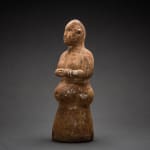Bactria-Margiana Archaeological Complex stone fertility figurine, 2500 BCE - 1800 BCE
Stone
25.4 x 9.5 cm
10 x 3 3/4 in
10 x 3 3/4 in
SF.083
Further images
Bactria Margiana Archaeological Complex (BMAC) is a modern collective term referring to the combined area of archaeological discoveries that point to the existence of a hitherto unknown uniform bronze age...
Bactria Margiana Archaeological Complex (BMAC) is a modern collective term referring to the combined area of archaeological discoveries that point to the existence of a hitherto unknown uniform bronze age civilization in central Asia area.
News of this lost civilization began leaking out in the 1970s, when archaeologists came to dig in the southern reaches of the Soviet Union and in Afghanistan. Bactria is the ancient Greek name for northern Afghanistan and the northeast corner of Iran, while Margiana is again an ancient Greek name for what is today Turkmenistan and Uzbekistan.
Through the region runs the Amu Dar'ya River, which was known in Greek history as the Oxus River. Western scholars subsequently used that landmark to dub the newly found culture the Oxus civilization.
The complex mainly stretches within a large continuous zone between southern Turkmenistan and Northern Afghanistan, and smaller adjacent areas of Iran, Uzbekistan and Tajikistan.
The exact identity of the BMAC culture has yet to be fully identified due to the lack of written evidence at the sites excavated up to know. However the material evidence which has been brought to light is strongly indicative of proto Indo-Iranian and proto-Zoroastrian practices, which offers a very unique testimony of what the common culture of the original indo-Iranians in the area was before they split off into the Indic and Iranian branches.
News of this lost civilization began leaking out in the 1970s, when archaeologists came to dig in the southern reaches of the Soviet Union and in Afghanistan. Bactria is the ancient Greek name for northern Afghanistan and the northeast corner of Iran, while Margiana is again an ancient Greek name for what is today Turkmenistan and Uzbekistan.
Through the region runs the Amu Dar'ya River, which was known in Greek history as the Oxus River. Western scholars subsequently used that landmark to dub the newly found culture the Oxus civilization.
The complex mainly stretches within a large continuous zone between southern Turkmenistan and Northern Afghanistan, and smaller adjacent areas of Iran, Uzbekistan and Tajikistan.
The exact identity of the BMAC culture has yet to be fully identified due to the lack of written evidence at the sites excavated up to know. However the material evidence which has been brought to light is strongly indicative of proto Indo-Iranian and proto-Zoroastrian practices, which offers a very unique testimony of what the common culture of the original indo-Iranians in the area was before they split off into the Indic and Iranian branches.







